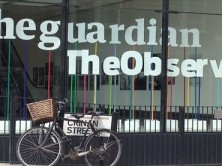A scan of the print version of the Dominion Post's report, via Mediaite.
The Dominion Post, a West Virginia newspaper, made national news this week after publishing a three-sentence report saying police were looking for a black man “involved in some suspicious activity” without any details of the activity or what the person looked like. As Mediaite, which got a print version of the article (above) put it best in its headline: “Black Man Suspected of Suspicious Stuff, West Virginia Paper Reports.”
But, in a print apology, the newspaper’s editor denied “racism or discrimination” were “behind the brief’s publication,” which she admitted was “offensive.”
Instead, the editor, Geri Ferrara, explained that the Jan. 11 report was supposed to be accompanied with a surveillance photo provided by police but was cut because it was poor quality. Ferrara addressed the problem in a letter to readers published Jan. 14. Post managing editor Pam Queen provided the apology to iMediaEthics. Ferrara’s letter, “Saturday news report riddled with errors” explained, “A succession of errors resulted in the publication of an item Saturday that poorly reflects on the integrity of this newspaper.”
Ferrara summarized the issues: “The incomplete news brief neglected to include basic information so the reader would understand why it was noteworthy. Most importantly, the item failed to adequately describe the suspect.”
What happened is The Dominion Post‘s reporter slightly tweaked the police’s request for information, which included a photo of the person in question. But, the newspaper didn’t print the photo, which would have provided identifying information about the person. Ferrara wrote:
“The copy desk decided the photo would reproduce poorly — they decided not to run the photo. It would have been a good decision if a proper description accompanied the news brief but it didn’t.”
The report then made it to publication because staff didn’t catch it during late-night deadlines.
Ferrara listed the newspaper’s “policy on suspect descriptions,” noting that the article in question didn’t meet the standard. The policy is, she wrote:
“The Dominion Post‘s policy on suspect descriptions dictates that race isn’t enough — anymore than gender alone is not enough if a description is successful — in that it points to a specific individual or eliminates suspects from contention. Sadly that didn’t stop the item from appearing in print Saturday.”
Besides Ferrara’s print apology, on the online version of the report, which provided much more information, the Post‘s Cassie Shaner wrote in the comments section that the dubious print report was a “copy editor’s error.”
In its online article, the Post provided actual details about that “suspicious activity” and what the man they were seeking looks like, along with a few photos of him. The online version of the report says that the man “may have information about stolen credit cards,” and described him with his estimated height and age as well as what type of car he drives.
Shaner’s comment read:
“Due to a copy editor’s error, an item was published in The Dominion Post on Saturday without a full description of a suspect sought by the Monongalia County Sheriff’s Department in connection with stolen credit cards. The corrected item with the full description ran in the Sunday edition of The Dominion Post and was published on TheDPost.com late Saturday with three photographs.”
In print Jan. 12, the newspaper also included a more detailed report on the police request with a small surveillance photo of him.
Columbia Journalism Review talked to Deputy J.D. Morgan, listed by the newspaper as the police officer seeking the man, about the print version of the report. Morgan said he’s “been taking flak over [the report] for two days now.” He added that the man they were looking for is not a suspect but because of the print report, he’s been getting lots of phone calls.
“Usually, it’s just sarcasm from people,” Morgan is quoted as saying. “Hey, I’ve seen a black guy walking and he looks suspicious, I hear you’re looking for him.”
Back in 2010, The Dominion Post produced one of iMediaEthics all-time favorite Photoshopped news photos for its sheer ridiculousness in a side-by-side comparison with the original.
The paper took a photograph of six politicians and Photoshopped out three of them for a front-page photo. Check out the side-by-side comparison below, via the Charleston Gazette‘s 2010 report.

While the Post did note the photograph was an illustration, the explanation for the photo-doctoring was also a unique one. The photographer, Martin Valent, was shocked, telling West Virginia Public Broadcasting at the time, “I’ve never seen anything like this on a newsworthy article like this, never. This is beyond my comprehension.”
More from our 2010 story:
WVPB reported that The Dominion Post’s editor, Geri Ferrara, said the newspaper’s policy is to not publish candidates running for re-election during that season.
Funny, because ABC-affiliate WCHS reported May 19 that The Dominion Post ran a photo of 1st district congressional candidate Mike Oliverio on its front page May 11. Maybe the newspaper’s policy isn’t so strict?
UPDATE: 1/16/2014 10:11 AM EST: Fixed datestamp (story was published on Jan 15 not 16.)







Comments Terms and Conditions